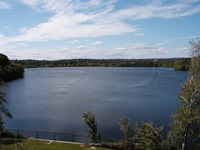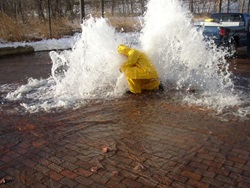Distribution


TRANSMISSION AND DISTRIBUTION - Responsible from Beginning to End
The Distribution Division of the Water Department is responsible for installing, maintaining and repairing the Transmission and Distribution Systems. The Transmission and Distribution systems are a series of piping networks which convey the city's water supply from the reservoirs in Waltham all the way to the last flowing tap on the east end of the city. The piping networks and appurtenances are made up of over 200 miles of pipeline ranging from 4-63 inches, over 15,000 service connections, approximately 1,800 fire hydrants, and 4,500 valves.
TRANSMISSION
The Transmission System pipeline starts in Waltham where water is conveyed from the Stony Brook Reservoir to Fresh Pond via the 63 inch Stoney Brook Conduit. The water is then purified at the Walter J. Sullivan treatment plant, located within the Fresh Pond Reservation, and pumped up to the Payson Park Reservoir, located in Belmont, via a 40-inch transmission pipeline. The elevation associated with the Payson Park Reservoir, provides the hydrostatic head necessary to allow the treated water to flow by gravity back down to the gatehouse at the Cambridge Common via a 40-inch transmission main where it then enters the distribution system.
DISTRIBUTION
Once the water leaves the Cambridge Common Gatehouse it flows out through the distribution system in a spider web like network of piping, that if strung out in a straight line would be over 180 miles long. The piping in the distribution system ranges in size from 4 - 30 inches and carries the purified drinking water to every Home, Business, School, Park, Community Garden and fire hydrant in the city.
Cambridge is an old and historic city which has prided itself on building an infrastructure to serve the community for hundreds of years. In the mid 1800s the planning, design and engineering for the current Transmission and Distribution systems was set in motion and by the late 1800s a majority of the piping systems were installed and operational. Today over 60 miles of the original 180 plus miles of piping are still in operation carrying potable water throughout the city.
The age and complexity of this system often presents the Distribution Division with unique and challenging work as we strive to provide an uninterrupted water supply, from the first tap to the last tap, all year round while continuing to upgrade and improve the system. Keeping the water flowing requires a constant effort of designing, planning, implementation and coordination with the city's Department of Public Works (DPW) as well as all other public and private utilities. This coordinated effort exists with the DPW in connection with our ongoing rehabilitation of the water distribution system and the DPW's sewer separation and Chapter 90 Road way improvement projects. Water infrastructure improvements are often performed in conjunction with these projects whenever feasible and as funding allows. This cooperative effort not only reduces cost and improves efficiency, but also minimizes disruption to the public by incorporating all foreseeable work into a single City construction project. Additionally, this coordination effort extends to all other utilities performing work in the public way such as gas, electric, telephone and Cable TV.